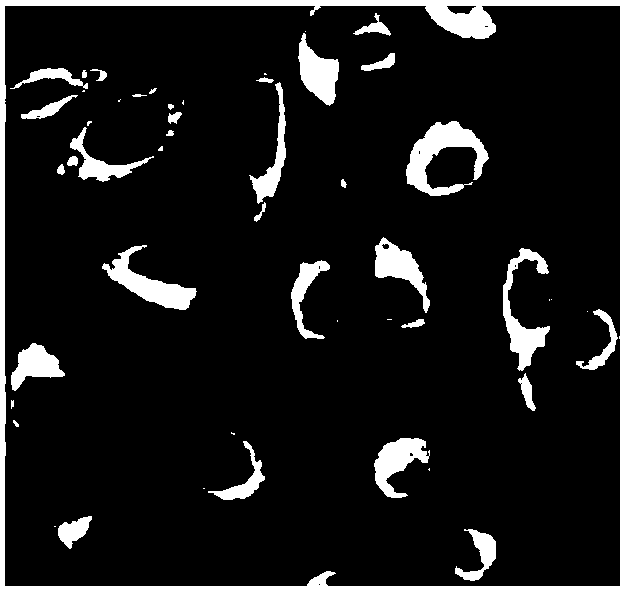Composite nano-grade novel material based on cancer early-stage integrated detection, diagnoses, and treatment, and preparation method thereof
A technology for early detection and new materials, applied in the field of nanoscience, can solve the problems of low sensitivity and specificity, difficult detection, drug resistance, etc., and achieve the effects of high sensitivity and accuracy, improved accuracy, and stable performance
- Summary
- Abstract
- Description
- Claims
- Application Information
AI Technical Summary
Problems solved by technology
Method used
Image
Examples
preparation example Construction
[0041] A method for preparing a new composite nano material based on the integration of early detection, diagnosis and treatment of cancer as described above is characterized in that: the specific steps are as follows:
[0042] (1) Take the silver nanocube as a template and add AuCl 2 - And AuCl 4 - , The hollow gold nanocube-shaped particles (nanoboxes) and hollow porous gold nanocage-shaped particles (nanocages) were prepared, and the hollow gold nanocube-shaped particles were used H 2 O 2 Corrosion to obtain angled hollow gold nanocubic box-shaped particles, such as figure 1 Not in
[0043] (2) Add 0.02 mol FeCl to the hollow gold nanocubic box particles and hollow porous gold nano cage particles obtained in step (1) 2 ·6H 2 O dissolved in 200mL deionized water and FeCl 3 ·4H 2 O, Fe 3+ With Fe 2+ The molar ratio is 1.75, and the reaction precursor solution is stirred rapidly, and ultrasonically oscillated to ensure Fe 2+ And Fe 3+ The solution can enter the hollow gold nanocage o...
Embodiment 1
[0066] Take Au Nanocages / Fe 3 O 4 As an example to prepare biological probes
[0067] (1) Reference literature [Chinese Sci Bull, 2010, 55] Preparation of Nano Fe 3 O 4 For particles, refer to the literature [Adv Mater, 2008, 20] to prepare gold nanocages or gold nanocube boxes.
[0068] (2) Take (1) 2g 10mmol of Au Nanocages particles and add 0.02mol FeCl 3 ·6H 2 O is dissolved in 200mL deionized water to make a 0.1mol / L solution, Fe 3+ With Fe 2+ The molar ratio is 1.75. When the reaction starts at 60°C, first add 30mL of ammonia water, and then add 0.5mL of surfactant when the temperature is raised to 80°C. The aging time is 40~130min; the stirring speed is close to 300r / min to obtain composite nanoparticles .
[0069] (3) At room temperature, add 1.5 mL of 20% PDDAC aqueous solution into 5 mL of deionized water and stir quickly, then slowly add the 7nM Au Nanocages / Fe prepared in (2) 3 O 4 The solution is 5mL, after continuing to stir for two hours, centrifuge at 15000rpm for 30 ...
Embodiment 2
[0074] Synthesis of 2,3-dimercaptosuccinic acid (DMSA) modified nanocomposites
[0075] (1) Reference [J Colloid Interface Sci. 1997, 194: 427-433] method, add 1mL DMSA solution (3mM) to 1.5mL nanocomposite colloidal solution (7.0×10 12 particles / mL), slightly stirred for 2 hours to obtain DMSA-modified composite nanomaterials.
[0076] (2) Centrifugally wash (1) with Milli-Q water to remove unreacted DMSA (3000 rpm). The nanomaterials were re-dispersed in 3 mL of aqueous solution for later use.
PUM
| Property | Measurement | Unit |
|---|---|---|
| particle diameter | aaaaa | aaaaa |
| particle diameter | aaaaa | aaaaa |
Abstract
Description
Claims
Application Information
 Login to View More
Login to View More - R&D
- Intellectual Property
- Life Sciences
- Materials
- Tech Scout
- Unparalleled Data Quality
- Higher Quality Content
- 60% Fewer Hallucinations
Browse by: Latest US Patents, China's latest patents, Technical Efficacy Thesaurus, Application Domain, Technology Topic, Popular Technical Reports.
© 2025 PatSnap. All rights reserved.Legal|Privacy policy|Modern Slavery Act Transparency Statement|Sitemap|About US| Contact US: help@patsnap.com



